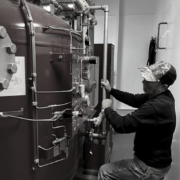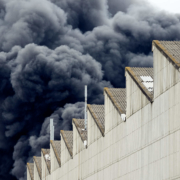The 100th Year of Fire Prevention Week
Since 1922, the National Fire Protection Association has sponsored the public observance of Fire Prevention Week. Throughout the past century, fire prevention week consisted of children and adults learning how to stay safe in case of a fire. Additionally, firefighters provide lifesaving public education in an effort to drastically decrease casualties caused by fires.
In this article, we’ll review the history of fire prevention week and reveal the 2022 campaign. Let’s dive in.
The History of Fire Prevention Week
In 1925, President Calvin Coolidge proclaimed Fire Prevention Week a national observance. This makes Fire Prevention Week the longest-running public health observance in the United States.
Why FPW is the Week of October 9th
Fire Prevention Week is observed each year during the week of October 9th in commemoration of the Great Chicago Fire. According to History.com, the Great Chicago Fire “burned from October 8 to October 10, 1871, and destroyed thousands of buildings, killed an estimated 300 people and caused an estimated $200 million in damages.”
Fire prevention week occurs during the same week each year to honor the lives lost in the Great Chicago Fire and make efforts to prevent similar events from happening in the future.
The 2022 “Fire Won’t Wait. Plan Your Escape” Campaign
The campaign of the 2022 Fire Prevention Week™ (FPW) is “Fire won’t wait. Plan your escape”™. The campaign for 2022 strives to educate participants about simple but important actions they can take to keep themselves and others safe from home fires. Key focuses of this campaign include fire escape planning and practicing as well as alarms.
Why Fire Escape Plans Are so Important
According to NFPA, today’s homes burn faster than ever. In the event of a fire, you have about two minutes or less to safely escape from the time the alarm arounds. One’s ability to get out of the home during a fire depends on early warning from smoke alarms and advanced planning.
How to Start Creating a Fire Escape Plan
Every home is different and therefore, every fire escape plan will be different. Consider starting with these guidelines:
- Draw your building floor plan using a grid.
- Label all the rooms and identify the doors and windows.
- Plan two escape routes from every room.
- Provide alternatives for anyone with a disability.
- Agree on a meeting place where everyone will gather after you have escaped
Fire escape plans should consider everyone in the home or building. For example, children, older adults or people with disabilities may need additional assistance. Consider assigning someone to help them in the event of an emergency.
While NFPA is focusing on home fires, these same concepts carry into commercial fires as well. An updated fire protection system and a practiced escape plan can save the lives of people in commercial buildings. Those working or owning commercial buildings can practice fire safety by ensuring their fire escape plan is well-known and practiced.
Let’s Talk Fire and Smoke Alarms
Smoke alarms sense smoke well before people can and should effectively alert people of danger. As a general rule, alarms should be:
- In every bedroom
- Outside of the sleeping areas (such as a hallway, for example)
- On each level, including the basement
Smoke alarms should not be installed over the stove or in bathroom shower areas. The heat from these areas may trigger the alarm.
The requirements for commercial buildings differ from standards for homes. We urge owners of commercial buildings to research the requirements for their property. Find more information on NFPA 72, here.
For more information about NFPA’s Fire Protection Week, check out their website!
At VFS, our mission is to grow our business by serving our community and protecting that which matters most to our clients; life and valued assets. As the provider of choice within our markets, we provide complete fire protection and integrated life safety solutions, focused exclusively on exceeding our customer’s expectations every time.
Learn more about who we are and why we do what we do, here.













